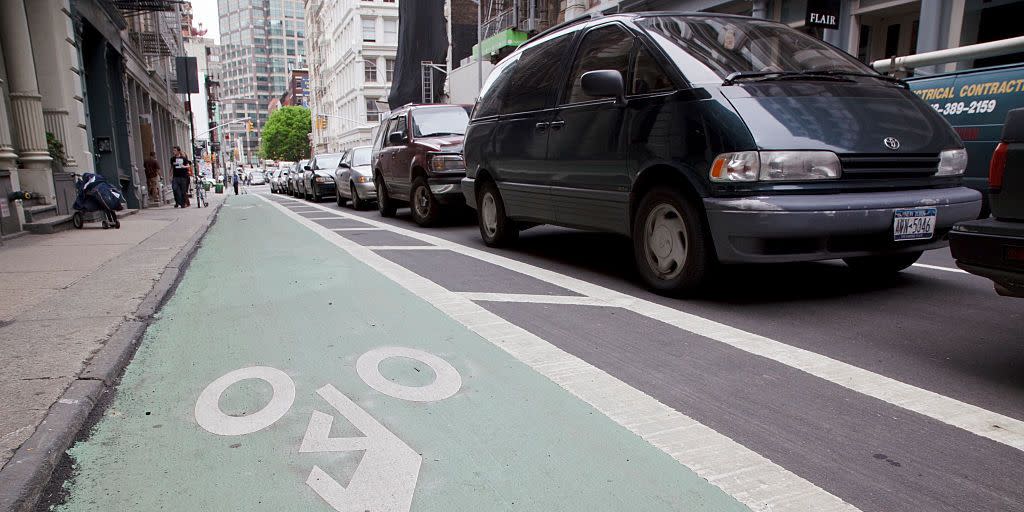NYC Will Expand to “Super Sidewalks” in Latest Redesign

New York City’s Department of Transportation has announced a new plan for “Super Sidewalks” to be built along Ninth Avenue from 50th to 59th Streets, which will include changes to the current protected bike lane along that corridor.
According to a press release shared this morning, the “major redesign of Ninth Avenue expands pedestrian space and upgrades New York City’s first on-street protected bicycle lane.”
The redesign was included as part of a $231-million project to upgrade Manhattan’s water distribution system, “as well as safety improvements along one of Midtown’s major corridors.”
The stretch of Ninth Avenue through the busy Hell’s Kitchen neighborhood is designated as a Vision Zero Priority Corridor, which is a ranking of the corridors in each of New York’s five boroughs on which people were killed or seriously injured.
With this redesign, the city will remove one southbound lane of vehicle traffic on Ninth Avenue and create an 11-foot-wide painted sidewalk on the Avenue’s east side, adjacent to the existing sidewalk and where the protected bike lane currently sits. The bike lane will move west and will see a four-foot-wide safety buffer installed between it and a row of parking and pedestrian islands. Beyond that will be three lanes of southbound traffic, a bus and parking lane, and the westside sidewalk.
Though it maps out those changes, the press release does not specify exactly how the bike lane will be “upgraded,” per its language.
Work included the installation of painted sidewalk extensions from W 59th St to 50th St joining other Manhattan "Super Sidewalks"; a protected #BikeNYC lane; expanded commercial loading space; and redesigned intersections with new pedestrian islands and “offset crossings.” pic.twitter.com/GXAEo6nNlr
— NYC DOT (@NYC_DOT) March 21, 2023
The announcement also highlighted planned work later this year to build protected bike lanes on 10th Avenue, along with upgrades further south along Ninth Avenue between 30th and 34th Streets. Those parking-protected bike lanes along 10th Avenue will eventually stretch from West 14th to West 52nd Streets.
“The City is moving in the right direction towards its commitment to reclaim public spaces for people instead of cars,” said Ken Podziba, president and CEO of the advocacy group Bike New York. “It’s about street equity. More equitable streets lead to a safer, more equitable city.”
“Their intentions are good. They just need to speed up whatever plans they have to reclaim the streets from cars,” Podziba added.
Vision Zero was introduced in New York City 2014 by then-Mayor Bill de Blasio, with the aim of eliminating all traffic deaths and serious injuries in the city by 2024. In 2018, New York City saw its number of traffic deaths decrease to its lowest since the implementation of Vision Zero, when 202 people were killed. That number has ticked back up over the last few years, however.
Despite Mayor Eric Adams recent claims that New York City’s street safety is improving, data would suggest otherwise. In a 2022 report by the advocacy group Transportation Alternatives, it was noted that last year’s death toll of 255—while down from the 275 killed in 2021—was still a 24% increase from that 2018 nadir.
“As we near the 10-year mark of Vision Zero, it’s clear we haven’t moved fast enough to address this crisis,” Executive Director of Transportation Alternatives Danny Harris wrote in the report.
In the wake of Mayor Adams’ pledge to become New York City’s first bike-centric mayor, the City Council approved a plan in 2019 to build 250 miles of protected bike lanes over a five-year period. However, Adams’s administration is on pace to fall far short of that, with just over 30 protected miles built last year, according to the annual Mayor’s Management Report. In order to stay on pace for their goal, 75 miles of protected bike lanes needed to be built.
You Might Also Like

